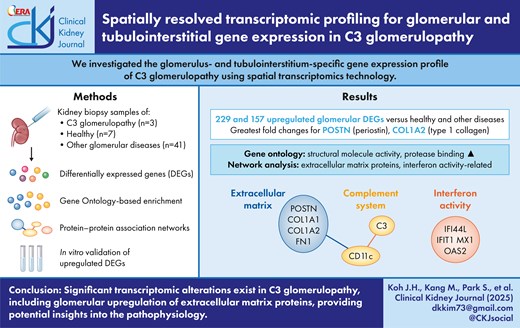-
PDF
- Split View
-
Views
-
Cite
Cite
Jung Hun Koh, Minji Kang, Sehoon Park, Ha Yeon Shin, Hyunah Ku, Seong Min Lee, Jeong Min Cho, Semin Cho, Yaerim Kim, Soojin Lee, Hajeong Lee, Kwon-Wook Joo, Kyung Chul Moon, Seung Hee Yang, Hyun Je Kim, Dong Ki Kim, on behalf of the KORNERSTONE investigators, Spatially resolved transcriptomic profiling for glomerular and tubulointerstitial gene expression in C3 glomerulopathy, Clinical Kidney Journal, 2025;, sfaf139, https://doi.org/10.1093/ckj/sfaf139
Close - Share Icon Share
Abstract
C3 glomerulopathy (C3G) is a rare but clinically significant glomerulopathy. However, little is known about its transcriptomic profile. We investigated the substructure-specific gene expression profile of C3G using the recently introduced spatial transcriptomics technology.
We performed spatial transcriptomic profiling using GeoMx Digital Spatial Profiler with formalin-fixed paraffin-embedded kidney biopsy specimens of three C3G cases and seven controls from donor kidney biopsy. Additionally, 41 samples of other glomerulonephritis, including focal segmental glomerulosclerosis, membranous nephropathy, and minimal change disease, were included as disease controls. We identified differentially expressed genes (DEGs) specific to C3G, followed by in vitro validation analysis of consistently upregulated DEGs in human glomerular endothelial cells through a co-culture with complement-stimulated macrophages.
We found 229 and 157 highly expressed DEGs in the glomeruli of C3G compared to those of donor and disease controls, respectively, including POSTN, COL1A2, and IFI44L. Protease binding, structural molecule activity, and extracellular matrix structural constituent were among the top enriched gene ontology terms in the glomeruli of C3G. Specifically, genes related to the extracellular matrix and interferon activity were the most upregulated, with network analysis suggesting possible interactions between complement C3 and the extracellular matrix through CD11c. The in vitro experimental validation using iC3b-stimulated CD11c + macrophages supported these findings, inducing elevated expression of fibrosis markers and extracellular matrix components in glomerular endothelial cells.
Significant disease-specific transcriptomic alterations in C3G, including upregulation of genes related to the extracellular matrix, provide potential insights into the pathophysiology.

Author notes
Jung Hun Koh, Minji Kang and Sehoon Park Co-first authors




Comments